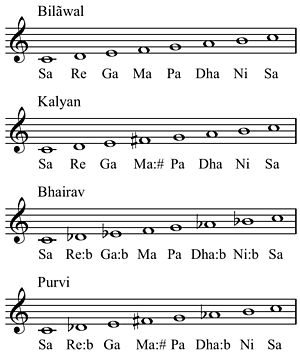ථාට
ථාටයක් (හින්දි: ठाट; මරාඨි: थाट; බෙංගාලි: ঠাট; also transliterated as thaat) is a mode in Hindustani music. Thāts always have seven different pitches (called swara) and are a basis for the organization and classification of ragas in North Indian classical music.
| හින්දුස්තානී ශාස්ත්රීය සංගීතය |
|---|
 |
| සංකල්ප |
| ප්රභේද |
| ථාට |
| තාල |
| රාග |
පද්ධතිය
[සංස්කරණය]නූතන ථාට පඬතිය විෂ්ණු නාරායන් භාත්ඛණ්ඩේ විසින් විසිවන දශකයේ මුල් දශකයේ නිමැවිණි.[1][2] භාත්ඛණ්ඩේ modeled his system after the කර්ණාඨක සංගීතය melakarta classification, devised around 1640 A.D. by the musicologist Venkatamakhin. Bhatkhande visited many of the ඝරණ (පාසල්) of උතුරු ඉන්දියානු සංගීතය, conducting a detailed analysis of Indian raga. His research led him to a system of ten thāts, each named after a prominent raga associated with it. Many correspond to one or other of the European church modes. They are listed here according to their pitches; lower-frequency pitches are represented with lowercase letters and higher-frequency pitches with uppercase letters.

- බිලාවල් රාගය (=Ionian mode): S R G m P D N S'
- ඛමාජ් රාගය (=Mixolydian mode): S R G m P D n S'
- කාෆි රාගය (=Dorian mode): S R g m P D n S'
- ආශාවරී රාගය (=Aeolian mode): S R g m P d n S'
- භෛරවී රාගය (=Phrygian mode): S r g m P d n S'
- භෛරව රාගය: S r G m P d N S'
- යමන් රාගය (=Lydian mode): S R G M P D N S'
- මාර්වා රාගය: S r G M P D N S'
- පූර්වි රාගය: S r G M P d N S'
- තෝඩි රාගය: S r g M P d N S'
One can arbitrarily designate any pitch as Sa (the tonic) and build the series from there. While all thāts contain seven notes, many ragas (of the audav and shadav type) contain fewer than seven and some use more. A raga need not use every swara in a given thāt; the assignment is made according to whatever notes the raga does contain (but see note 5). The relatively small number of thāts (compared to the 72 melakartas of South Indian music) reflects Bhatkhande's compromise between accuracy and efficiency: The degree of fit between a raga and its thāt is balanced with the desire to keep the number of basic thāts small.[3] Ambiguities inevitably arise. For example, Raga Hindol, assigned to Kalyan thāt, uses the notes S G M D N, which are also found in Marwa thāt. Raga Jaijaivanti contains both shuddha nishad and komal nishad (and sometimes both versions of gandhar as well), which by definition corresponds to no thāt. Bhatkande resolved such cases "by an ad hoc consideration, appealing to musical performance practice" (see Ramesh Gangolli's article, cited in note 4 above).[3] Each thāt contains a different combination of altered (vikrt) and natural (shuddha) notes. The flattening or sharpening of pitches always occurs with reference to the interval pattern in Bilawal thāt.
In effect only heptatonic diatonic scales are called "thāt."[4] Bhatkhande applied the term "thāt" only to scales that fulfill the following rules:
- A thāt must have seven notes.
- The notes must be in sequence: Sa Re Ga Ma Pa Dha Ni (whether shuddha or vikrt—both versions of a single note are not allowed).
- A thāt, unlike a raga, does not have separate ascending and descending lines.
- A thāt has no emotional quality (which ragas, by definition, do have).
Thāt and time of performance
[සංස්කරණය]Ragas are normally ascribed to certain periods of the day and night (See Samay). Narada's Sangita-Makaranda, written sometime between 7th and 11th century, gives warnings to musicians against playing ragas at the incorrect time of day. Traditionally, disastrous consequences are to be expected.[5] Bhatkhande stated that the correct time to play a raga had a relation to its thāt (and to its vadi).
මූලාශ්ර
[සංස්කරණය]- ^
Vishnu Narayan Bhatkhande (1909–1932). Hindustani Sangeet Paddhati. Sangeet Karyalaya (1990 reprint). ISBN 8185057354.
{{cite book}}: CS1 maint: date format (link)This is the four-volume work in which Bhatkhande, after thorough analysis, makes the case for the ten thāts. Originally written in Marathi, it has been widely translated. - ^ Vishnu Narayan Bhatkhande (1974). A Short Historical Survey of the Music of Upper India. Indian Musicological Society.
- ^ a b Ramesh Gangolli (1992-12-23). "Chatura Pandit : V.N.Bhatkhande". සම්ප්රවේශය 2007-04-11.
- ^ Jairazbhoy (1995)
- ^ Kaufmann (1968)
සාහිත්යය
[සංස්කරණය]- Jairazbhoy, N.A. (1995), The Rags of North Indian Music: Their Structure and Evolution, Bombay: Popular Prakashan
- Kaufmann, Walter (1968), The Ragas of North India, Calcutta, New Delhi, Bombay: Oxford and IBH Publishing Company
